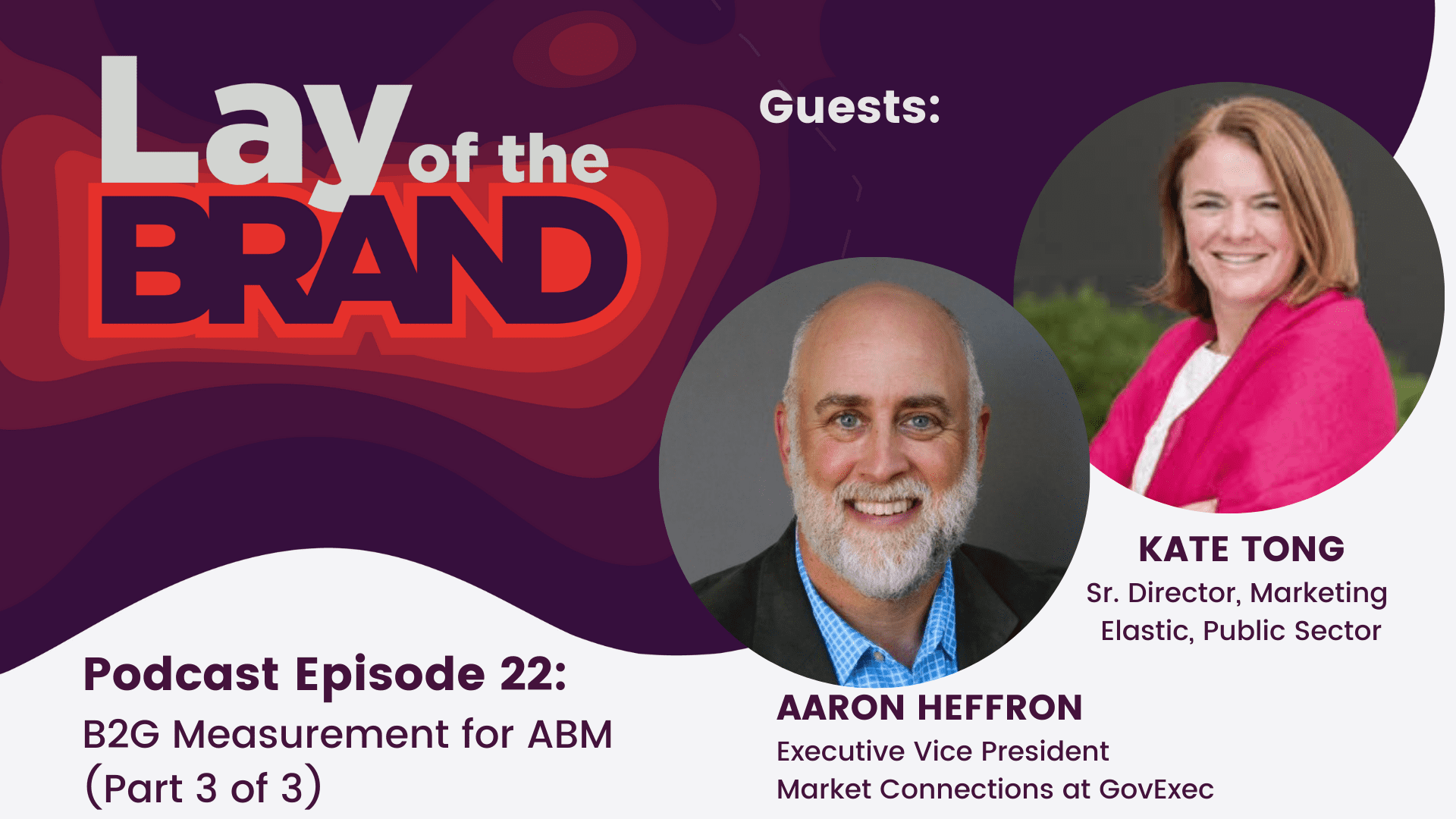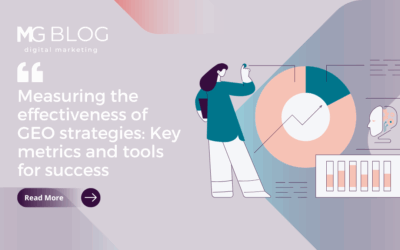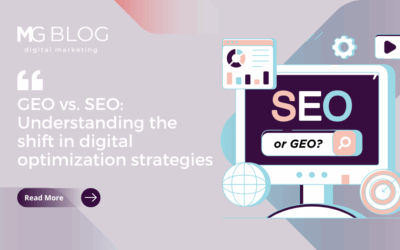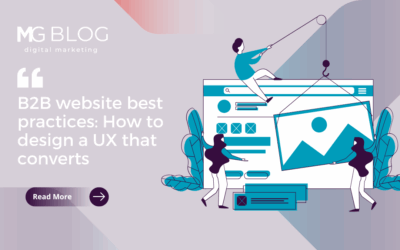
In the final segment of our three-part series on federal account-based marketing, Peter Jacobs of Merritt Group is joined by Aaron Heffron, Executive Vice President of Market Connections and Kate Tong, Senior Director of US Public Sector Marketing for Elastic to explore the launch and measurement your B2G ABM campaign.
In past episodes, we’ve asked Aaron and other guests to spell out the importance of research and developing the right message for your audience as the keys to ABM success. This time, we dive into understanding the best channels to reach your target audience and best practices for measuring results.
For a free download of Understanding Agency Needs for ABM, click here.
Here are the highlights of our conversation. Click below to listen to the podcast or visit layofthebrand.com.
Which channels work best?
Peter Jacobs, Lay of the Brand: Kate, when you’re getting ready to launch your ABM program, what are you considering? Do you generally use different channels to message to mission leaders versus tech leaders, or is it one size fits all?
Kate Tong, Elastic: It’s definitely not one size fits all. Mission leaders are looking at outcomes and strategies and impact on the agency mission, whereas tech leaders are looking at more features and future considerations. We understand that our developer/technical audience here at Elastic has a different lexicon and we have to speak in their language to create the commonality. And then with mission leaders, we have to speak to their concerns and their goals in the right language and in the right setting. There’s definitely some overlap, but
Our strategy has been to cultivate a variety of mature channels where we can reach those individual audiences and speak their languages.
Those channels vary from third-party events to our own hosted events, to territory-specific events depending on where the user customer is on their journey with us.
We do a lot of ABM naturally in Fed, right? And as an example, the DoD – and more specifically the Army, Navy, Air Force — we know where we can reach our audience. And with the myriad of events specifically for this audience or the associations or even the publications, we know where we can find them.
But we also build our own channels. For example, we recently launched a program for veterans offering technical training for folks looking to grow their careers in tech. This is very focused on developers and end-users, and we are using this channel to target tech talent and cultivate relationships with our tech leaders and future tech leaders.
Peter Jacobs, Lay of the Brand: Aaron, in previous episodes of Lay of the Brand, you’ve talked about how companies don’t have infinite resources. So, it may make sense for them to look for the commonality in their campaigns. But how does that work from a campaign perspective considering the different needs and the different personas?
Aaron Heffron, Market Connections: It’s always a challenge. As we know, what you want to do in marketing is bound by a couple of different things — the resources you have, both human and monetary, of what you want to go forward; the timeframe in which you want to be able to make an impact; and the breadth of audience that you want to reach.
So I tend to look at the research and the other bit of information we have through the light of “What is it that’s common across everybody,” and use that as a foundation and then tailor what you can around the edges. And it really comes down to two pieces. One, is tactically, how are you going to reach them; and then foundationally of what are you going to say? And some of those things lend themselves to be more common across everybody.
I try to counsel, to say, “Find some common elements and then maybe focus the details on the tactical way in which you reach them. What events are they going to, what publications and websites are they visiting? What are the different ways that they like to receive information?”
There’s a greater ability to be able to tweak and customize in the delivery mechanism, more so than necessarily the root messaging.
Especially for smaller/midsize companies that don’t have a lot of resources to put forward, I’d say, “pick your battles.”
Peter Jacobs, Lay of the Brand: So even if you’re going after some more niche audiences within an overall framework of an agency, or the DoD you still have an opportunity to get that economy of scale while tweaking, as you said, your delivery channels in order to reach the people you want to reach?
Aaron Heffron, Market Connections: At its root, there are some mission-based and other sorts of trust-related messaging that you can put in there that will resonate regardless of who it is — and your goal isn’t to necessarily make the sale with that piece. This is merely an introduction and getting them interested enough to pick up the phone, take a call. You’ve got to think about, “What is it that I’m really trying to accomplish with these pieces.”
Data to drive your marketing decisions
Peter Jacobs, Lay of the Brand: Kate, what kind of data are you looking for to inform these decisions and how does that influence your plans?
Kate Tong, Elastic: At the highest level, collaboration with key partners in our marketing organization, like demand gen and product marketing is certainly influential. We have a great partnership with those functions here at Elastic.
After we have those themes and thoughts from our partners in marketing, we go to our field sales organization –being in regional marketing and in the field, it’s very important to understand where do they want to focus and what are the accounts they want to go after. Then we start to build the campaign and our approach.
Once that is identified, we dig into the details.
We look at our database of users and customers as well as our external approach — because it is two-prong — and how we bring in the folks that we haven’t spoken to before.
We definitely take a persona-driven approach. In fact, Aaron, a little plug for Market Connections, we are a consumer of your Federal IT Persona study. That was very helpful for us and a great asset to share with our partners in marketing to help them understand our market further. Thank you for that wonderful asset.
Aaron Heffron, Market Connections: That’s great to hear. Those persona studies really came out of conversations like this, and that’s why we moved forward with those. We were hearing so much of individuals wanting to go that path in the federal space. It had been so successful in B2B and consumer for many, many years.
There was a question, “Can this play forward into a public sector space, and is there enough meat on the bones to really be able to do that sort of work?” We found that the data has been important to folks, confirming what many folks already knew.
Data is useful for that, of giving you a little bit of reassurance, reassuring the powers that be that you’re doing the right thing. Especially if you are in a company that has both commercial and public sector practices.
I’ve found that that is when the data can really be helpful for kind of the oft-forgotten public sector folks who are toiling away and marketing and trying to make a silk purse out of a sow’s ear from all of the commercial marketing materials. These are the sorts of things that have been helpful to lay on top of it.
Peter Jacobs, Lay of the Brand: Aaron, let’s talk a little more about data sources that are relevant to these kinds of decisions. Where are you finding data that can help support an ABM campaign launch?
Aaron Heffron, Market Connections: One thing that I have found is having systemic data across the market. The data has gotten better over the last five years. I think there’s been better tracking, better keeping information on customers and clicks and downloads — all that sort of stuff has definitely gotten better.
The next step is overlaying all of that kind of behavioral data with some of that attitudinal and perception information that we’ve been gathering. When you’re building that ABM campaign, you’re trying to evaluate what’s going to give you the most bang for your buck and what’s going to reach the largest audience.
What some of our clients have been successful in doing is saying, “I can reach 40% of my audience with advertising or putting downloads up on this website or this publication. If I add another publication for X dollars, I get 15% more. If I add a third one, maybe I get 6% more.”
We have found that that’s a great mechanism to try to reach a saturation point, when the ROI on your marketing dollar doesn’t reach many more eyeballs as you go. We’ll say, “You hit these publications, hit this webinar, you’ve reached 75%. Your next dollar’s not going to be worth it. So, spend it on creating something new or increasing the frequency of your buys in these publications.”
Partnering for success
Peter Jacobs, Lay of the Brand: Kate, a major mechanism for outreach involves using partners, such as the media, creative agencies, influencers. How can these partners help you launch and sustain your campaign? And when does it make sense to put your resources there?
Kate Tong, Elastic: Personally, I don’t think you have a campaign without the media partners, creative agencies, and/or influencers. But it all comes at a cost. And you absolutely must plan for and allocate a portion of your budget to execution.
You could have this great asset, but if you don’t have a way to get it out into market, it really doesn’t mean anything.
And you have to prioritize the channels that will most effectively help you achieve the goals and objectives that you define at the start of the campaign launch or ABM program.
Peter Jacobs, Lay of the Brand: Aaron, what can a partner do for you that you might not be able to do for yourself?
Aaron Heffron, Market Connections: The partner portion of this is always interesting. And I think of partners as not the folks that I’m going to pay to help me, like the creative agencies or marketing firms or whatnot. I think of the partners as who else has a vested interest in what I’m doing and may gain from partnering with me as much as I will gain from partnering with them.
And where I come back to is some of the data that we’ve seen over the last two years is a continued decline in trust of the federal contracting community. And it’s a decline in trust of whether they believe what we tell them.
People put out white papers, put out advertising, put out marketing messages and blogs, and increasingly we’ve seen a skeptical view from the audience saying, “Yeah, they’re just telling me what I want to hear,” or, “they’re going to over-promise and under-deliver. I don’t trust them.”
And we’ve seen the government contractors be at that lowest point of, “do I trust what they say.” Who is at the highest point?
The ones who I see successful partnerships with are professional and trade associations. To be able to envelop yourself in their halo really can benefit you.
Even if you position yourself more as a, “I’m here for the greater good to educate and help everybody understand what’s going on.” That in itself builds that trust. That, “Hey, I call them, they’re gonna tell me like it is and maybe at the end, I don’t go with them. They’re not going to hold it against me, or they’re not going to withhold something from me, and then maybe next time around, it is worth it to go with them.”
Kate Tong, Elastic: I couldn’t agree more. Here at Elastic, part of our marketing strategy in Fed is doubling down on associations simply because they give us that opportunity to reach our community of interest and those that we want to engage with and build relationships with. So, a hundred percent agree that the associations bring a very valuable mechanism to reach that group and often offer a lot of integrated campaign approaches based on the themes that we’re talking about in our programs.
Aaron Heffron, Market Connections: Yeah, I would say the key though, in those relationships, is to make sure that it’s content-focused and not just promotional-focused.
Buying a sponsorship and being a lead name on an event is not a partnership. It’s got to be where you are seated at the table with a person from their shop and your shop, talking as equals at the table.
You don’t get the benefit of knowing that your name’s going to be on the download. That’s not the same thing.
Measuring a campaign’s ROI
Peter Jacobs, Lay of the Brand: Something that sometimes gets pushed to the side during campaigns is how do you know you did a good job? Kate, how do you make sure that measurement gets baked into everything that you’re doing?
Kate Tong, Elastic:
The key is identifying your campaign or ABM objectives up front and determining which metrics will help you track to those objectives.
Building measurement into the work-back plan is important too. Getting something out to market quickly can be dependent on so many things. Maybe it’s dependent on an editorial calendar, on a topic that you want to attach yourself to, or a piece of content or an event. Whatever that might be you’ll need to identify and then work backward from that date.
Aaron Heffron, Market Connections: Kate, you stole a little bit of my thunder here as I was coming into this about the importance of setting out your outcomes and the desired goals at the very beginning. So many times, I’ve seen where it’s, the “throw the spaghetti against the wall” approach and get out there as much as possible. And in the end, if we increase sales, then we win.
In some of these ABM campaigns, you’re starting from scratch, where they don’t know you at all, in some cases you are going into a set of agencies that are already in the process of doing some selections and some decision making, and others are really in the final steps. And all the different campaigns have different goals of what they’re trying to accomplish.
Are you just trying to raise the level of awareness so people know you exist, so that you’re in the conversation at the beginning? Or are you trying to convince the customers that you can expand and do more than what you’re already doing?
I think those are two different things that you want to measure. And then the last is, “Am I part of the consideration set? Am I going to be one of those preferred two or three companies that they are always going to come to me when they have a question?”
All of those are different stages of the overall marketing funnel and I think if you can evaluate what area of the funnel you’re trying to affect first, then put the metric on top of that.
But if you don’t know what you’re looking for and what you’re trying to achieve from the beginning, or if you’re trying to achieve too much with one campaign, you’re just setting yourself up for questions up and down the food chain, as you’re trying to justify why you’re spending the money you are on this.
Final thoughts
Peter Jacobs, Lay of the Brand: Kate, any last thoughts about launching and maintaining an ABM campaign?
Kate Tong, Elastic: I think, whether you’re taking a campaign or an ABM approach, plan to be in it for the long haul, cultivate long-term visions, plan for tracking and iteration, and strategize for updates and expansion.
One more example I can offer, at Elastic, we have an ongoing effort around CDM that started in the summer of 2019. It’s still running today due to expansion of scope and product and solution capabilities and we’re adjusting as needed to be able to respond to that and continue to have that in-market.
Aaron Heffron, Market Connections: I would just say that don’t let “perfect” get in the way of being really good at this. You’re going to make mistakes. There’s going to be things that maybe aren’t a hundred percent of what they could be, but you’re better off getting out there and doing something — intelligently thought and derived from some good information from the beginning.
I’m not talking about getting out there with whatever knee jerk reaction comes to you first thing in the morning, but
Don’t have that analysis paralysis. People pull out what they need and discard the things that they don’t. And as long as you are generally in the ballpark on it, you’re going to have an impact.
Is it going to be, you know, the greatest impact you could have? No. But it’s better than having no impact at all.
Want to learn more about how to reach government decision-makers? Listen to the first or second episode of this 3-part podcast series and other episodes at layofthebrand.com on your favorite streaming platform and check out our B2B Marketing Hub.
For more information on Market Connections, click here. Check out their Federal IT Personas Study and Federal Media & Marketing Study.
For more information on Elastic, click here.



